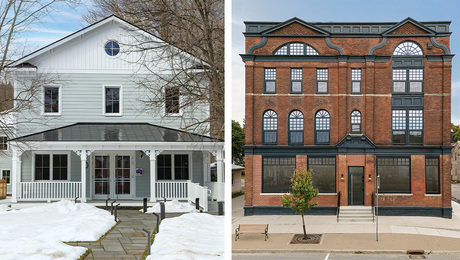I have a 3-way circuit that controls a light in a mudroom. The goal is to have motion detector switches at both ends of the room, for walking through with an armload of groceries in the dark, for example.
The way the room is shaped, the motion detectors don’t ‘see’ each other, there’s a closet that blocks the view, so someone entering one end of the room won’t be seen by the furthest motion detector until he’s in the middle of the room.
Originally, my thought was to put a 3-way motion detector switch at both ends of the circuit, so as the person is entering the room, the closest switch will see him and turn on the lights.
This doesn’t work, of course, because in the 3-way circuit, the motion detector ‘flips the switch’, it doesn’t ‘turn on the lights’. So, once the person is half way across the room, the other motion sensor switch sees him, ‘flips the switch’, and turns off the lights. Not exactly what I had in mind.
My only two ideas now both admit a certain level of defeat. 1) Install a separate light fixture for both ends of the room. This would work pretty well, but is admitting total defeat, and I’d need to move some lights around. 2) find some kind of out-board motion detectors that could be situated like a security systems’, switching on the lights via a relay – this seems fragile, expensive, and less aesthetic, but I have another application for it where #1 wouldn’t work, so it might be worth learning about.
Is there a method or product to solve this in-the-wall? Failing that any recommendations for products that implement idea #2 above would be appreciated.
Thanks,
-Bill



















Replies
You could go with an X10 controler that would open a lot of other control options up as well but the expense is probably a bit steep if this is the only trick you want this dog to perform.
Kevin Halliburton
"I believe that architecture is a pragmatic art. To become art it must be built on a foundation of necessity." - I.M. Pei -
There is such a thing called an "occupancy sensor". These are often used in office buildings and classrooms to turn off lights if they don't sense any movement for five minutes or so. They should be available at any electrical distributor [commercial].
I personally don't like them because I may be doing intricate work and don't move around enough to keep them awake so they leave me in the dark.
~PeterView Image
Presuming of course you're talking about a common 120VAC light fixture.............
You don't really need a 3-way motion dectector at all. You should be able to pull this off with the use of two common motion detectors. Run a load line from each detector to the common light unit(S) making certain that the line side (source) of both detectors is obtained from the same leg of your service box. It then won't matter which unit sees you first and closes the circuit. The circuit can only be closed once........so to speak.
By common motion detector, I mean the type which are readily available at any home center and simply replace the normal light switch. The "on" time since last motion was detected is adjustable on the ones I have installed here.
Knowledge is power, but only if applied in a timely fashion.
Edited 10/28/2003 10:59:03 PM ET by GOLDHILLER
Thanks for both responses. The occupancy sensor was what I was thinking about, but the wiring advice is probably the better way for me to go.
Thanks everybody!
-Bill
Bill,
The type of motion detector I was referring to.... is a type of occupancy sensor. When it detects your prescence, it will stay on for a predetermined amount of time and then turn off unless it detects motion again before turning itself off. The ones I have here also have an over-ride switch so if you know you're going to be in the room but inactive, you could simply walk over to one of them and turn it to that over-ride postion.
This arrangement should give you the best of both worlds........automatically turns the lights on when you enter (from either doorway), automatically turns off unless you tell it otherwise and can be over-ridden.
We've also set up two of these units this way to turn the lights on for a staircase. Saves hunting for the switch in the near dark of night or if your hands are full.
About $12-$15 each, I think.
Knowledge is power, but only if applied in a timely fashion.
Edited 10/29/2003 9:10:24 PM ET by GOLDHILLER
Bill,
http://forums.taunton.com/tp-breaktime/messages?msg=36162.7
Knowledge is power, but only if applied in a timely fashion.
> making certain that the line side (source) of both detectors is obtained from the same leg of your service box.
Not just the same leg, but the same breaker -- otherwise when both detectors turn on, you'd have cross connected circuits.
-- J.S.
You are correct, sir.
I should've said so, but obviously I forgot.
Knowledge is power, but only if applied in a timely fashion.